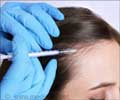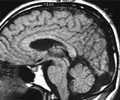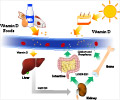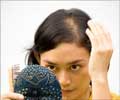Human hair can now be tested to know about Vitamin D levels, finds a new study.

‘Human hair testing method is advantageous over the blood test because blood test can sometimes be painful and require expertise and training along with hygienic conditions/equipment so getting a sample is not always easy.’





A new study by researchers from Trinity College Dublin and St James's Hospital has reported for the first time that vitamin D can be measured in human hair. Vitamin D deficiency has reached epidemic proportions worldwide, with over 1 billion people estimated to be affected. Deficiency has been linked with bone health, but it could also be a risk factor for depression, cardiovascular disease, inflammation, diabetes, and cancer. At present, the best way of assessing vitamin D is to measure the concentration of vitamin D in the blood. However, this can be painful, requires expertise and training along with hygienic conditions/equipment so getting a sample is not always workable.
Also, the blood result represents vitamin D status at a single time point, which is problematic because vitamin D changes with the seasons: it's not uncommon for someone to be sufficient in vitamin D in the summertime, and very deficient in the winter. This means that a single snapshot of vitamin D status is not able to provide information on vitamin D year-round.
The current study is the first in the world to publish that it is possible to extract and measure vitamin D in human hair. This is a major step forward in assessing vitamin D status, potentially one of the major innovations in vitamin D measurement. Traditional blood analysis captures just a moment in time; in contrast, hair, which grows at approximately 1cm per month, could reflect vitamin D status over several months capturing the large seasonal differences in vitamin D status.
The lead author of the study, Associate Professor in Epidemiology, Trinity College Dublin, Lina Zgaga said:
Advertisement
"Further research is needed to establish the exact relationship between vitamin D concentration in the blood and hair over time. We also need to investigate different factors that might affect vitamin D levels in hair, the most obvious ones being hair color and thickness, or use of hair products such as hair dye."
Advertisement
"Other applications could also include historical samples from archaeological sites. Hair (along with teeth) are some of the longest lasting surviving biological materials after death, and thus it could be possible to for the first time assess the vitamin D status of historical populations - Elizabethans, Viking, Celtic, Roman, ancient Chinese, Egyptian. Similarly, hair samples could also be used to assess longer-term vitamin D status in animals with applications to farming. The vitamin D status of ancient species could be measured given the well preserved and copious amounts of for example mammoth or ancient ice age animal hair that is often found from the warming permafrost and in museum specimens."
Principal Biochemist from the Biochemistry Department in St. James's Hospital and co-author Dr. Martin Healy said:
"The presence of vitamin D in hair could be interpreted as a personal record of a person's vitamin D status. Having knowledge of an individual's long-term vitamin D status through analysis of hair samples may allow for better strategies to maintain stable and adequate vitamin D concentrations over an extended period".
"The finding that vitamin D can be measured in hair samples potentially opens up a new approach to epidemiological studies relating the vitamin to a bone and non-bone related medical conditions which have been associated with its deficiency."
Source-Eurekalert














